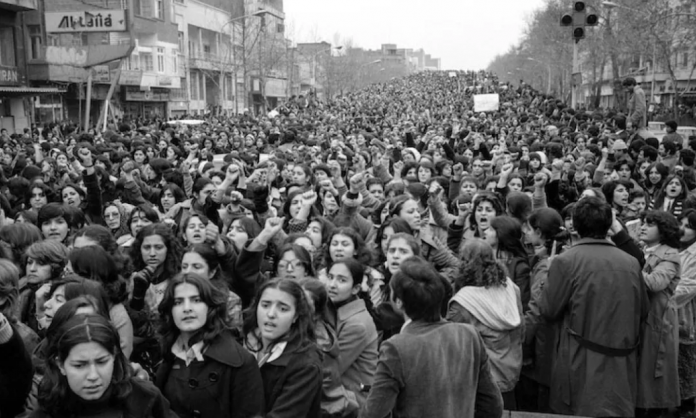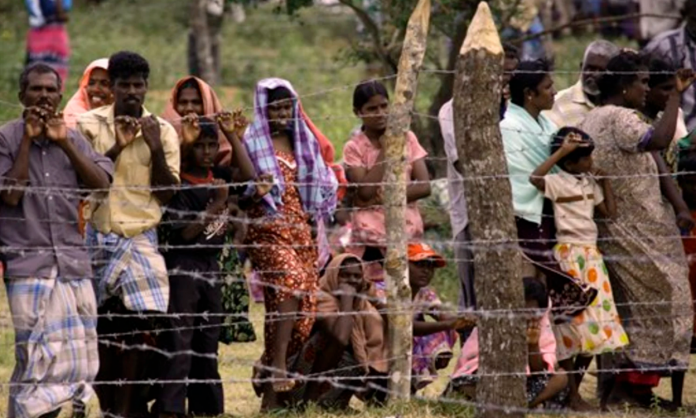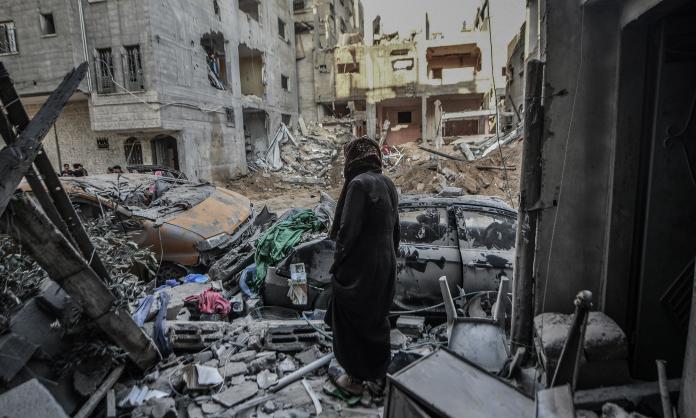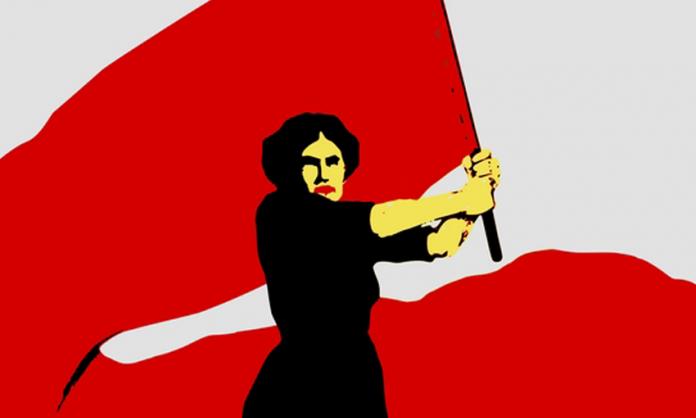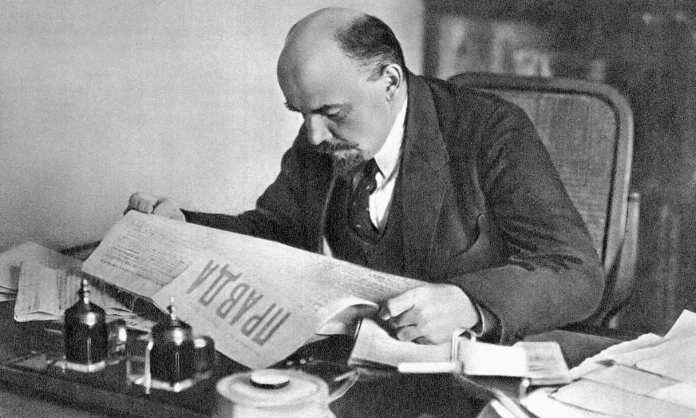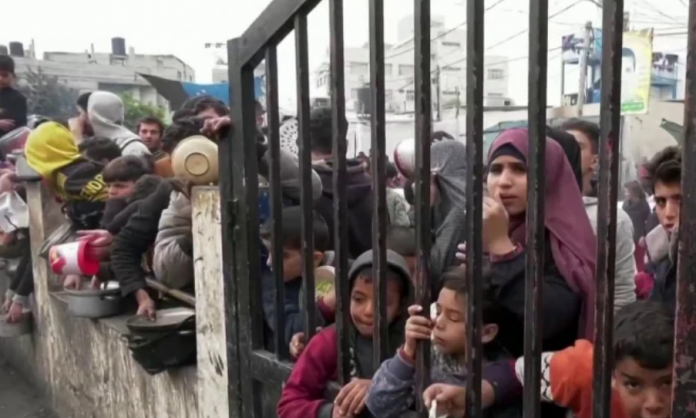Minoo Jalali was among those who resisted Ayatollah Khomeini’s rise to power in Iran. In the early months of 1979, she joined a mass women’s protest against the compulsory wearing of the hijab in public. “That revolution was inevitable”, Jalali recounted 40 years later in an interview with the Canadian Broadcasting Corporation. “Nobody could have really stopped the force of it. We hoped that we could steer it [but] we were wrong. And the clergy hijacked it ... and deceived many people.”
The Iranian revolution had promised liberation. Workers, women, nationally oppressed minorities, poets, artists, students, the unemployed, shopkeepers and religious leaders had overthrown the US-backed Pahlavi monarchy. Iran’s revolutionary workers created shuras, or workers’ councils—democratic assemblies that had emerged in all the great revolutions from Russia in 1917 to Chile just six years earlier. The shuras held the key to a society that could move beyond capitalism.
Yet by the end of 1979, the shuras had been transformed into Islamic Associations. By the end of 1980, hundreds of thousands of men were being lined up to fight and die in a brutal war against neighbouring Iraq. Conditions for the oppressed, particularly women and national minorities such as the Kurds, went backwards. While the Iranian monarchy’s state had been obliterated, Khomeini’s Islamic Republican Party became the new enforcers of capitalist oppression.
To understand how the promise was so quickly betrayed, we need some background.
In the decades preceding the revolution, Iranian capitalism was pulling in different directions. Shah Reza Pahlavi, the self-described “King of Kings” desired cosmopolitan cities without free political expression, and modernisation without angering landlords and tribal leaders. Iran’s reactionary monarchy—controlled by dynasties of the Pahlavi family—had cooperated closely with the British and then the Americans, both of whom wanted to control the country’s vast oil reserves. The absence of democracy in Iran’s political system was advantageous not only for the Shah, but for Western imperialism.
Bourgeois nationalists—Iran’s indigenous upper middle classes and capitalists—at times clashed with the Shah over who would control and benefit from the country’s oil wealth. The greatest challenge came in 1951, when Mohammad Mosaddegh, the popular leader of the bourgeois National Front, was appointed prime minister. Mosaddegh nationalised the Anglo-Iranian Oil Company, a 50 percent British-owned monopoly. Two years later, he was ousted in a coup that vested political power safely, again, in the hands of the Shah. Trade unions were outlawed; left-wing organisations were all but destroyed.
Following the coup, the Pahlavi family returned to a directing role in the Iranian economy. They wanted to “modernise” Iran and finance glamorous lifestyles for the elite, while putting down political challenges. Richard Kapuscinski, in his 1982 book Shah of Shah’s, writes that Reza Pahlavi would say, “With oil, I will create a second America in a generation”. The vision was encapsulated in a package of reforms called the White Revolution, which aimed to increase agricultural productivity and bring the powerful, occasionally rebellious, landlords and tribal leaders into the government’s fold. While a minority of landowners were enriched, the majority of landless, poor peasants were driven into destitution. In the decade preceding the revolution, an estimated five million peasants, or one-quarter of the rural population, migrated to the cities.
The modernisation programme promoted secularism, and pitched the Shah against the ulama, or Islamic religious experts. Home to 80,000 mosques, Iran’s clergy held considerable political and social clout. The clergy had previously rebelled against elements of the Shah’s secular policies, such as suffrage and government jobs for women. In 1963, this culminated in a mass movement, after which Ayatollah Ruhollah Khomeini, an influential cleric, was exiled. In the 1970s, a version of political Islam, which railed against Western influence and spoke in a combative tone about a struggle between the oppressed (mostazafin) and the oppressors (mostakhbarin) gained influence. This ideology, and the social layer espousing it, deeply connected to the shopkeepers or bazaaris, rejected the Shah’s excesses but remained firm advocates of private property.
To consolidate his project and to ward off potential challengers, the Shah constructed an army loyal to the monarchy. Iran became the biggest importer of armaments in the world. With the assistance of the CIA, a formidable domestic security force, known as the SAVAK, recruited possibly tens of thousands of covert agents. The SAVAK contributed to an atmosphere of fear and intimidation. Abbas Milani, an academic who was jailed by the regime in the late 1970s, told Al Jazeera journalists 30 years later, “Our working assumption in Iran was that in any group of four or five, one person would be assigned [by SAVAK]”.
The profitability of Iran’s oil industry skyrocketed following the formation of the Organization of the Petroleum Exporting Countries in 1960. Oil accounted for two-thirds of government revenue by the mid-1960s. “Modernisation” had created a wealthy elite and strengthened the middle classes but workers and the poor suffered greatly.
Despite Iran’s status as the most advanced Middle Eastern economy, networks of shantytowns—without water or electricity, containing houses constructed from junk—mushroomed on the peripheries of major cities to accommodate rapid immigration from the countryside. Workers suffered chronic under-employment, finding low-wage itinerant work in construction and services during booms, and nothing during slumps. Many workers were employed in small shops for dreadful wages. Most Iranian villages lacked schools and hospitals and suffered from poor sanitation.
Conditions for oil and petrochemical workers were different, however. In the 1960s and 1970s, productivity, mechanisation and employment in the oil industry dramatically increased. More than 50,000 workers were employed directly in oil extraction and refining, and tens of thousands more in transport, storage and maintenance. Given the centrality of oil to the Iranian economy, and the concentration of the workforces, the Shah was anxious to keep order.
Through short, sharp strikes, oil workers were able to win improved wages and conditions. In 1972, the average hourly wage of oil workers was 83 rials (the local currency), compared to 38 rials in the tobacco industry, 17 rials in the transport industry and 13 rials in the textile industry. Oil installations were policed by soldiers and heavily infiltrated by the SAVAK. In the absence of legal trade unions, company syndicates provided an avenue for workers to express their grievances. If left-wing or militant worker candidates gained support for representative positions in the syndicate, however, the army would bar their entry to the factory on election day. SAVAK agents spread rumours about the loyalties and affiliations of militant workers to erode workplace solidarity and generate mistrust.
Even for better off workers, factory conditions were dangerous and oppressive. Asef Bayat, in his book Worker’s and Revolution in Iran, based on field research in fourteen major Iranian factories in the years following the revolution, estimated that two industrial deaths occurred each day. “Everybody wants to speak out”, Bayat wrote of the situation in one metal factory. “You are told many things; and they are all grievances, complaints made loudly and angrily. Q. You have been working here on this 12-ton furnace for some nine years; have you had any disease? A. Disease?! All of us have got diseases, even mental disease of one kind or another. We’ve got no doctor, nobody to take our problems seriously. All of us have got something wrong; our hands, feet and so on are either burnt or injured.”
In the mid-1970s, collapsing oil prices triggered a recession. Unemployment and inflation skyrocketed. Rents rose by 200 percent in 1974 and doubled again in 1975. While wages in large manufacturing firms grew by 2.6 percent in 1977, inflation climbed 27.3 percent. An already beleaguered population was being squeezed, while the lavish lifestyles of the wealthy rolled on.
American artist Andy Warhol travelled to Tehran in 1978 to photograph the Shah and his wife. Bob Colacello, editor of Warhol’s Interview magazine, accompanied him on the journey. “Their villas wouldn’t have seemed out of place in Bel-Air—except for the Persian carpets besides the pools—and the women wore bikinis all day and haute couture by night”, Colacello wrote. Warhol’s portraits were set to be displayed at the Shiraz art festival in September. But shortly before the festival, the Ministry of Culture telegrammed that the event had been cancelled. Mass demonstrations were paralysing Tehran. Oil workers were striking for cheap housing. The revolution had begun.
The Shah’s modernisation project had strengthened the state but had eroded his already limited support. Landlords, the clergy, intellectuals, students, workers and peasants each had a bone to pick with the Shah. A relative easing of repression in the 1970s resulted in mounting criticisms. The National Front and intellectuals, encouraged by the new US President Jimmy Carter, demanded bourgeois freedoms and a reinstatement of rights granted in the 1905 Constitutional Revolution.
Mass opposition soon erupted among the poor and unemployed residents of the south Tehran slums. In June 1977, residents battled with police to prevent their makeshift homes from being bulldozed. They were mainly young men who had vacated ancestral homes in the countryside in search of urban prosperity, instead they were humiliated by poverty. They learned that society’s brutality was expressed in both the landlord’s thugs and the city police.
Slum riots transformed simmering grievances into public revolt. Rebellions coalesced at times accidentally. In October 1977, the Iranian Writer’s Festival hosted ten nights of poetry readings, known as Dah Shab. Each night, thousands gathered. On the fourth, authorities used force to disperse the crowd. A spontaneous demonstration, raising anti-Shah chants, pushed back the police. International figures—including Jean-Paul Sartre, Simone de Beauvoir and Allen Ginsberg—voiced their support for the writers and gave publicity to the anti-Shah dissent.
The clergy, led by the exiled Khomeini, emerged as the most influential opposition. To appease them, the Shah closed gambling venues, abolished the Ministry of Women’s Affairs and attacked left-wing organisations. This only strengthened the hand of the popular and combative religious leaders. Khomeini began calling for the overthrow of the Shah. Supporters smuggled tapes of his lectures to broadcast in the mosques. Meanwhile, Khomeini spoke to the international media, denouncing the Shah and raising his own profile. Through the tens of thousands of mosques, the clergy commanded an important base of influence among the urban poor. When the Shah attempted to play opposition groups against each other by scapegoating the bazaaris, this economically powerful sector was pushed into the Islamist camp. The bazaaris provided important funds for Khomeini’s campaign, and repeatedly shut down markets in support of protests.
The regime resorted to violence. In January 1978, theology students demonstrated against an article defaming Khomeini in a government newspaper. Security forces opened fire, murdering 60 students according to some estimates. This prompted a cycle of mass demonstrations, as every 40 days—the end of the mourning period in Shi’ite Islamic tradition—masses would gather to honour martyrs and express opposition to the Shah.
At times, the regime’s brutality was unbridled. In September 1978, the army murdered more than 1,000 demonstrators in what became known as Tehran’s “Black Friday”. This followed days of marches numbering up to half a million people demanding Khomeini’s return and the overthrow of the government. The protests were the largest in Iranian history. The Shah might have been able to wait them out had the character and intensity of the revolution not been transformed by mass strikes in the final months of 1978. Some industries and workplaces had struck earlier in the year but a September strike wave begun by Tehran’s oil workers soon engulfed the country. Bayat describes the situation:
“On 6 October alone railway workers in Zahedan, 40,000 steel-workers in Isfahan, workers in the copper mines of Sar Cheshmeh and Rafsanjan, at Abadan Petrochemical, at Isfahan Post and Telegraph Company and all the branches of the Bank of Shahriar went on strike. The day after was the same: all the refineries, the Royal Air Services, the Iranit factory in Ray, the customs officers in Jolfa, the Department of Navigation and Port Affairs on Bandar Shahpour, Tractor Sazi in Tabriz, radio at TV stations in Rezayah, 80 industrial units in Isfahan, a steel-mill in Bafgh, employees of the judiciary throughout the country and employees of the Finance Department in Maragheh joined in.”
Most significant were the oil strikes, which raised increasingly political demands. The Abadan Strike Committee demanded the unconditional release of political prisoners and the dissolution of the SAVAK. The strikes were devastatingly effective: production was cut to zero by November, and the government’s income dropped by nearly one-quarter. Shortly after the strikes began, Time magazine interviewed the Shah, describing “an immensely saddened man” with “little life and much caution in his voice”. In November, the United States ambassador in Tehran bemoaned, “Iran’s oil supplies are the regime’s jugular vein. To cut these supplies is to cut the Shah’s throat”.
The following month, a general strike paralysed the country and threatened the regime’s collapse. The United States government began distancing itself from the Shah, and Iran’s religious opposition more confidently pressed for his ousting. In January 1979, the Shah fled to Egypt. Officially, he was “on vacation” but revolutionaries knew what they had achieved. Celebration gripped Iran’s streets: vendors distributed sweets freely, statues of the Shah were toppled. Mutinies swept the military. Assisted by guerrilla fighters, mutineers seized barracks, armouries and the parliament. On 16 February, an attempted coup by imperial guards, the only armed forces still loyal to the Shah, was stifled. The final vestige of the monarchical state was destroyed. The last Shah was never to step foot in Iran again.
After more than fourteen years, Khomeini had returned from exile triumphant on 1 February and soon appointed Mehdi Bazargan as prime minister in a provisional government. The new regime was anything but stable. An economic crisis and capital flight sent unemployment soaring, and different revolutionary institutions competed for popular control.
In the liberatory atmosphere of revolution, new institutions of democracy were created to coordinate protest activities and, increasingly, economic affairs. The most important bodies were the shuras, or factory councils, that had emerged across the country. The shuras had been created by workers to organise production. Beginning as extensions of strike committees, the shuras posed a fundamental challenge to capitalist exploitation. The exact structure of shuras varied but most adopted a democratic form with elected delegates and derived their legitimacy from regular general assemblies. “We have formed and appointed this shura to be in charge of the factory, to sort out the affairs and problems”, one worker told Bayat. “We have built the shura for the sake of our revolution.”
Shuras were popularised as a mode of organising among peasants and students and within the armed forces as well. Among the urban poor, neighbourhood komitehs emerged as mass participatory institutions. Shuras demanded control over hiring and firing, the purging of SAVAK agents and a ban on the dismissal of militant workers. They demanded access to company finances and decision-making power over how funds were spent. When management fled abroad, shuras took over the operation of factories to keep them running. In government-owned industries in particular, the shuras behaved in part as trade unions or shop stewards’ committees, although with greater militancy and intervention.
The shuras were widely seen as instruments of workers’ control, despite different interpretations of what this meant. A sense of ownership and radicalism permeated the factories. Participation in the shuras transformed the consciousness of workers involved. “Nowadays you don’t need to tell a worker to go and work”, a Melli Shoe Plant worker related to Bayat. “He works himself; why? The reason why he didn’t work [under the Shah] was because he was under the boss’s thumb. He couldn’t speak out. Now, he’ll say: ‘The work is my own. I’ll work’.”
The independent action of workers, which had secured the Shah’s downfall, was now seen as the biggest threat to the stability of the Iranian bourgeoisie and its new political regime. Khomeini ordered a return to work. The new Islamic Republican Party was internally divided about how a post-Shah Iran would operate, but all factions agreed that the shuras needed to be destroyed and the capitalist economy stabilised. Institutions such as shuras and komitehs gave workers and the poorest people in society an economic and political power that needed to be put back in the hands of the exploiting classes.
The komitehs were more easily influenced by Khomeini and the clergy. Khomeini wanted to remain close to the mass movement in order to control it, presenting the new Islamic Republic as a champion of the oppressed. Left-wing dissidents were slandered as being allies of the oppressors and were purged from the komitehs, which over time became the key base of support for the Islamic Republican Party. Out of the urban poor participants in the komitehs, Khomeini organised Islamic Revolutionary Guards, or pasdaran, which were first sent into battle to crush an uprising of Kurdish fighters for national liberation. The pasdaran increasingly replicated the role of the SAVAK, spying on, intimidating, beating and killing leftists and worker leaders.
Khomeini’s counter-revolutionary forces intervened to limit the activity of shuras. Employing moralistic, Islamist ideology, the state argued to transform shuras into Islamic Associations, with declarations that interruptions in the process of production were against Islam. In workplaces where this was successful, shuras took on a corporatist structure and members of left-wing organisations were barred from standing as candidates. A leader involved in one such shura described: “Our revolution is an Islamic revolution. We haven’t made a communist revolution. So, the shura members must hold Islamic views”.
Repression increased. A new law was introduced, prescribing two to nine years’ jail for individuals who “disrupt the business in the country’s workshops and factories or encourage workers to stop working or close the workshop or factory”. The counter-revolution successfully limited the activity of shuras. By the middle of 1979, initiatives by workers to control the factories had largely been stifled. The remaining shuras had been defanged, rebranded as Islamic Associations tasked with creating “a spirit of co-operation and solidarity between all the employees and the management”. At the end of 1979, Khomeini was appointed the first Supreme Leader of Iran. Although strikes continued intermittently, the challenge to capitalism had been thwarted.
Throughout his years in exile, Khomeini had constructed a mass following. Yet the triumph of Islamist counter-revolution was by no means guaranteed. Workers accepted neither immediately nor easily that their desires for control over their lives should be sacrificed to religious dogma. “They say we have not made revolution for economic betterment!”, Bayat quotes a factory worker in Azmayesh saying in 1981. “What have we made it for, then? They say for Islam! But what does Islam mean then? We made it for the betterment of the conditions of our lives.”
In March 1981, at the Iran Cars factory, a dispute over the non-payment of wages resulted in the arrest of the shura leadership. Representatives of Khomeini visited the factory and were confronted by an Azerbaijani worker who warned: “Just as we brought down the Shah’s regime, we are able to bring down any other regimes”. But Khomeini and his network of clergy had the most organised political forces in Iran, capable of arguing, bullying and influencing masses of workers and the urban poor across the nation.
The most influential organisations on the Iranian left were the Maoist, guerrilla outfits of the Fedayeen and Mojahedin. Politically, the organisations differed only in their attitude towards religion: the Fedayeen were stubbornly secular, while the Mojahedin wanted to merge Islamism with Stalinism. Both organisations adhered to what can be called a “stagist” view of revolution, which held that the immediate goal was the achievement of a “bourgeois democratic” or “anti-imperialist” revolution, socialism being relegated to a distant future. In Iran, the argument was that the left should support the purportedly progressive and anti-imperialist Iranian bourgeoisie against sections of the capitalist class tied to the West.
This amounted to class collaboration: the independent demands of workers should be shelved for the “national interest”. Bizhan Jahani, a Fedayeen theorist, wrote in Capitalism and Revolution in Iran, “Unity and co-operation must be extended to cover all nationalist forces. Any organisation that is engaged to fight against the dictatorial regime and imperialism can enjoy the support and co-operation of the vanguard proletarian revolutionary organisations”. This meant that precisely when the Islamic Republican Party was arguing for national unity and against the “sectional” demands of the workers, all the left could do was agree.
The left grew in popularity during the revolution, appearing to provide an alternative to more conservative organisations such as the pro-Soviet Tudeh Party. The Fedayeen was able to mobilise 150,000 people for a demonstration at Tehran University in 1979 and was respected for its prominent role during the February revolution. Neither the Fedayeen nor the Mojahedin, however, had the political forces or orientation to combat Khomeini’s counter-revolution in the shuras. Indeed, the organisations did not have a specific orientation to the working class at all. Although led by middle-class students in the cities, the organisations were influenced by Maoist ideas that viewed guerrilla struggle in the countryside as the most important revolutionary activity. This resulted in them overlooking the revolutionary potential of the shuras.
What would have been needed to continue the fight for workers’ power? First, a determined political argument to expose the counter-revolutionary nature of Khomeini’s forces. Second, a determined fight against the class collaborationist arguments of both the nationalists and Islamists and for working-class independence. The task was to prevent the consolidation of a new bourgeois state and to press for a second revolution against the new regime. The shuras could have provided a basis for this, if they were linked into citywide and nationwide formations—extended into an institution capable of acting as an alternative state, a workers’ government. The working class, through the shuras, would have had to win leadership of the whole revolution, acting as what Lenin called the “tribune of the oppressed”, taking up the cause of women, the poor, students and national minorities.
All this would have required a revolutionary party clearly committed to workers’ power. Yet no organisation was fit for the task. “In March 1979 thousands of women protested against the new gender policies of Khomeini, in particular the decree that made wearing the hijab obligatory”, writes historian Peyman Jafari. “The left gave lip-service to women’s rights but did not take concrete steps to defend them and called on supporters to refrain from those protests because most of the participants were from the middle and upper classes”. The left also refused to support the bitter and sometimes violently repressed struggles of the country’s national minorities.
By the middle of 1979, Khomeini had begun employing the rhetoric of anti-imperialism to build support for the new capitalist state. Supporters of the shuras, women who refused to wear the veil and all opponents of Khomeini were branded dupes of United States and of the Zionists. In November, student supporters of Khomeini occupied the US embassy as part of a factional struggle within the Islamic Republican Party. The revolutionary left was unable to see through the cynicism of Khomeini’s anti-imperialist rhetoric, and unable to adequately gauge the counter-revolutionary role of the Islamic Republican Party and distinguish it from other political forces. This confusion bore tragic consequences.
In September 1980, Saddam Hussein’s government in Iraq launched a war against Iran. Supported by the United States, Hussein hoped to exploit the crisis in Iran to extend Iraq’s regional influence and prevent the spread of rebellion through the Middle East. For Khomeini, the war provided an unparalleled nation-building opportunity. He called on all patriotic Iranians to sacrifice for the new Islamic State. The war atmosphere provided a pretext for greater repression of independent political activity and the banning of the shuras in early 1982. The war destroyed many oil facilities, and forced thousands of the most class conscious, rebellious workers to emigrate. Rather than resist this bloodletting, the left-wing parties supported the Islamist government, which repaid their loyalty with increasing repression, culminating in the mass execution of leftist leaders in 1988.
The defeat of the Iranian revolution casts a long shadow. The state that emerged in 1979 shared nothing of the revolution’s liberatory aims. It unleashed terror to crush genuine fighters against oppression. Khomeini’s Islamic Republic continued the Shah’s programme of developing Iran into a regional power, while introducing some of the most reactionary social policies on earth. This terrible defeat was not inevitable. The Iranian revolution was one of the twentieth century’s greatest uprisings. The working class created organs of radical democracy that went half-way towards challenging for power. Had Iran’s revolutionary socialists been better organised than the reactionary clergy, the uprising might have followed a different course.




